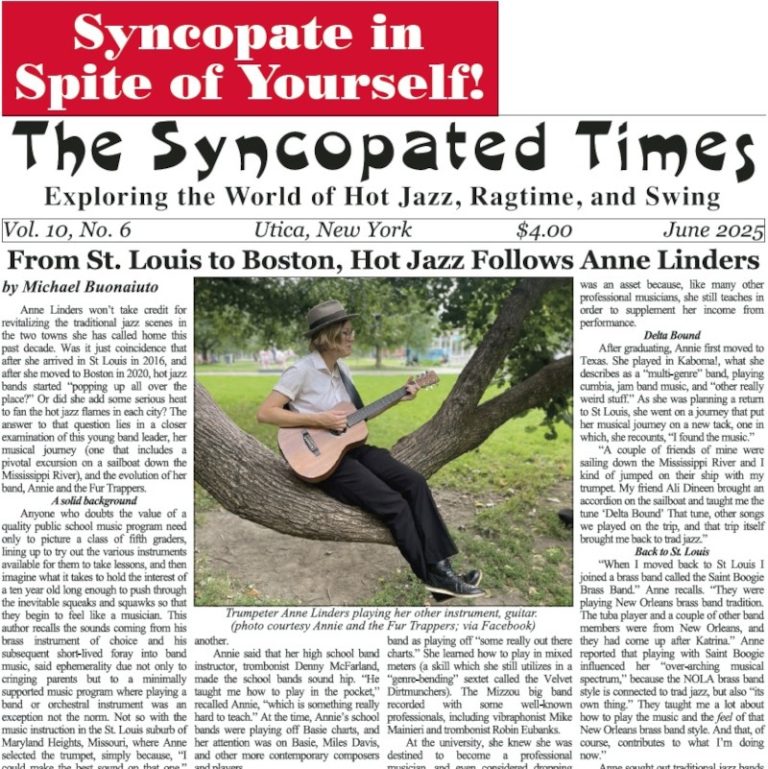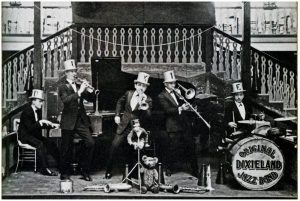
On Feb. 26, 1917, the Original Dixieland Jazz Band recorded “Livery Stable Blues” and “Dixie Jass Band One-Step” (soon better known as “Original Dixieland One-Step”).
While there had been a small handful of borderline jazz recordings cut before that special date, the ODJB’s offerings were the first full-fledged jazz on records. The commercial success of “Livery Stable Blues” as a novelty number (with the group’s horn players imitating the sound of barnyard animals) led to an early “jazz craze” that found other five-piece bands doing their best to emulate the group.
The Original Dixieland Jazz Band actually had a fairly short time in the spotlight. They were not the first jazz musicians (Buddy Bolden, Freddie Keppard, Jelly Roll Morton, Kid Ory, and other New Orleans greats preceded them) but, due to their recordings, they initially made the biggest impact.
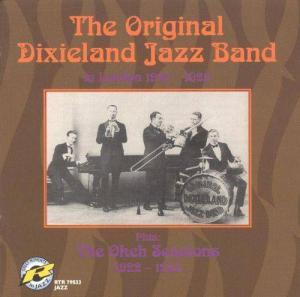 In 1916, cornetist Nick LaRocca, trombonist Eddie Edwards, clarinetist Alcide “Yellow” Nunez and pianist Henry Ragas were members of drummer Johnny Stein’s Dixie Jass Band in Chicago. But after three months of being a hit at Schiller’s Café, Stein’s sidemen wanted to break the contract so as to work elsewhere for more money. When Stein refused, they mutinied and left, formed the Original Dixieland Jazz Band, and hired Tony Sbarbaro as their new drummer. The ODJB had success playing at the Del’Arbe although a personality conflict resulted in Nunez leaving and Larry Shields taking his place.
In 1916, cornetist Nick LaRocca, trombonist Eddie Edwards, clarinetist Alcide “Yellow” Nunez and pianist Henry Ragas were members of drummer Johnny Stein’s Dixie Jass Band in Chicago. But after three months of being a hit at Schiller’s Café, Stein’s sidemen wanted to break the contract so as to work elsewhere for more money. When Stein refused, they mutinied and left, formed the Original Dixieland Jazz Band, and hired Tony Sbarbaro as their new drummer. The ODJB had success playing at the Del’Arbe although a personality conflict resulted in Nunez leaving and Larry Shields taking his place.
The ODJB moved to New York in early 1917 where they became a sensation playing at Reisenweber’s and made their initial recordings. Sticking exclusively to ensembles (their only solos were two-bar breaks), the ODJB’s music was considered not only boisterous but riotous by audiences of the time. Older listeners were scandalized but the younger generation loved the uptempo pieces, uninhibited ensembles, and the hot dance rhythms.
The ODJB introduced such future Dixieland standards as “Darktown Strutters Ball,” “Indiana,” “Tiger Rag,” “At The Jazz Band Ball,” “Fidgety Feet,” “Sensation,” and “Clarinet Marmalade.” Tragically Henry Ragas was a victim of the influenza epidemic of 1918-19, being succeeded by J. Russell Robinson. Eddie Edwards was drafted in the fall of 1918 and replaced by Emile Christian.
In 1919 the ODJB was the first jazz band to visit Europe, becoming the rage of London and recording some of their finest performances. But when they returned to the U.S., the competition from other jazz groups and the fast pace in jazz’s evolution found the band being overshadowed. Record company executives insisted that they add altoist Bennie Krueger to some of their recordings which sweetened the music a bit although they had a minor hit with “Margie.” The band struggled through some personnel changes, made only four recordings during 1922-23, and broke up altogether at the beginning of 1925.
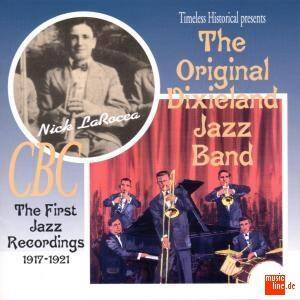 While Robinson had success as a songwriter and Sbarbaro continued playing jazz, the three horn players slipped away into obscurity and retirement.
While Robinson had success as a songwriter and Sbarbaro continued playing jazz, the three horn players slipped away into obscurity and retirement.
In 1936, Nick LaRocca decided to bring back the band and see what would happen. With Edwards, Shields, Robinson and Sbarbaro, LaRocca made some new recordings, appeared on the radio, and had a brief comeback. But by February 1938 it was over. LaRocca permanently retired and, although Shields and Edwards appeared on a few recreation sessions, they also soon dropped out of music. Only Tony Sbarbaro (as Tony Spargo) continued playing including with Phil Napoleon’s Memphis Five in the late 1940s.
While there has not been a single box set that includes all of the Original Dixieland Jazz Band’s recordings, two reissues give collectors all but nine of their 1917-23 recordings. The First Jazz Recordings has the band’s complete output for Victor, the recordings that essentially launched the Jazz Age.
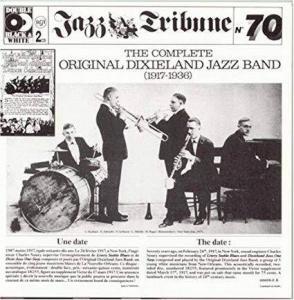 In London 1919-1920 Plus The Okeh Sessions lives up to its name, including all of the ODJB’s London recordings (with the highlights including surprisingly relaxed and classic recordings of “I’m Forever Blowing Bubbles,” “Mammy O’ Mine,” “I’ve Lost My Heart In Dixieland” and “Alice Blue Gown”) plus their final four selections from 1922-23 before the group’s initial breakup.
In London 1919-1920 Plus The Okeh Sessions lives up to its name, including all of the ODJB’s London recordings (with the highlights including surprisingly relaxed and classic recordings of “I’m Forever Blowing Bubbles,” “Mammy O’ Mine,” “I’ve Lost My Heart In Dixieland” and “Alice Blue Gown”) plus their final four selections from 1922-23 before the group’s initial breakup.
If one wants the quintet and big band performances from the ODJB’s comeback in 1936 too, The Complete Original Dixieland Jazz Band, a two CD set, has all of the music from The First Jazz Recordings plus the later recordings. In any case, get some of these CDs and one will have all of the tools that they need in order to fully celebrate the centennial of jazz on record.
The First Jazz Recordings (Timeless CBC-1-009, 23 selections, TT = 70:58)
In London 1919-1920 Plus the Okeh Sessions 1922-1923 (Retrieval 790332, 21 selections TT = 72:40)
The Complete Original Dixieland Jazz Band (RCA 66608, 37 selections, TT = 105:15)
Since 1975 Scott Yanow has been a regular reviewer of albums in many jazz styles. He has written for many jazz and arts magazines, including JazzTimes, Jazziz, Down Beat, Cadence, CODA, and the Los Angeles Jazz Scene, and was the jazz editor for Record Review. He has written an in-depth biography on Dizzy Gillespie for AllMusic.com. He has authored 11 books on jazz, over 900 liner notes for CDs and over 20,000 reviews of jazz recordings.
Yanow was a contributor to and co-editor of the third edition of the All Music Guide to Jazz. He continues to write for Downbeat, Jazziz, the Los Angeles Jazz Scene, the Jazz Rag, the New York City Jazz Record and other publications.






